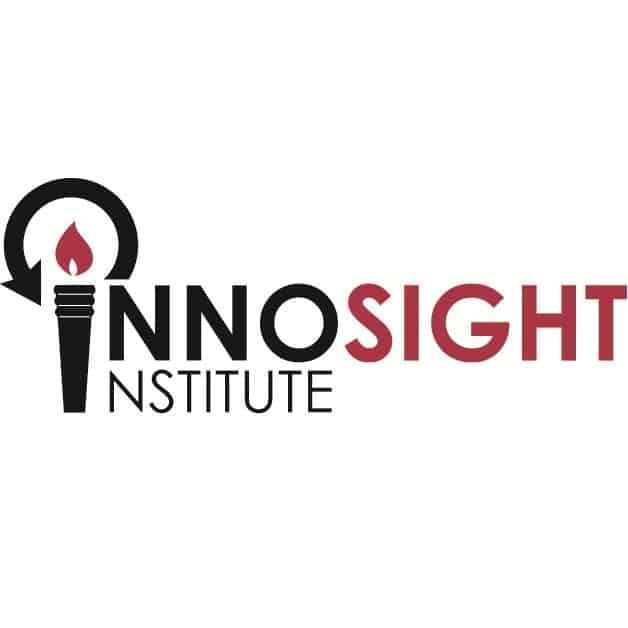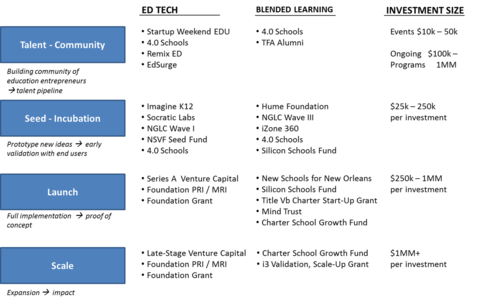Investing in Education Innovation

“Investing in Education Innovation” by Alex Hernandez was first seen on the Innosight Institute blog.
Ask yourself, would the next Rocketship Education or Goalbook grow in your backyard? If not, what would it take? One thing is for sure: education innovation does not happen by accident.
Tom Vander Ark recently made some great suggestions of different ways to invest in blended learning by dollar size.
Here is a broader framework for how philanthropists can support education innovation and, in particular, accelerate new ideas in local markets. The framework generally holds whether investing in next-generation school models, education technology, or other potentially disruptive innovations.
Innovation has several distinct phases of development and it needs support across the entire life cycle. The three phases are:
- Seed-Incubation. In this first phase, education entrepreneurs prototype their ideas and seek early, positive feedback from users. Edu-preneurs may iterate their ideas many times before choosing an approach to pursue further – or they may abandon their efforts altogether. Imagine K12, 4pt0 Schools, Socratic Labs, and New York’s iZone 360 are all incubation efforts that help education entrepreneurs give form to new ideas. Incubation often occurs in cohorts and typically involves a combination of financial, programmatic and networking support. Foundations can also play a seed investor role like the New Schools Seed Fund does in the edtech market, providing crucial capital at a time when it’s just the edu-preneur and an idea. Seed investments can range between $25 – 250k each.
- Launch. The launch phase involves fully implementing the idea with multiple end users. In this phase, edu-preneurs seek proof-of-concept through a clear set of compelling results. New Schools for New Orleans is an example of an organization that provides start-up grants to edu-preneurs launching new charter schools. Launch investments typically range between $250k – 1MM each, although these investments can be much larger for education technology organizations.
- Scale. This phase provides expansion capital to rapidly increase the impact of the best ideas. My non-profit, the Charter School Growth Fund, invests philanthropy in the nation’s highest-performing charter school networks so they can dramatically increase the number of students they serve. Scale investments typically have multi-million dollar, multi-year structures.
There is a fourth category of investment, Talent – Community, that builds the pipeline of edu-preneurs for ‘downstream’ incubation and launch. Great edu-preneurs are pure gold and hard to come by. But we can cultivate communities of edu-preneurs. Think how Stanford University develops talented entrepreneurs for Silicon Valley or Teach For America nurtures the next generation of education leaders. Rapidly scaling organizations, like Facebook or Google, can also be rich sources of talent as the most entrepreneurial leaders seek earlier-stage opportunities where they exercise more control.
New Talent-Community initiatives are emerging in the education innovation space. For example, Startup Weekend EDU and Teacher Square build communities of educators and technologists and let them collaborate on new edtech ideas. While we have come to expect this sort of “goodness” in Silicon Valley, 4pt0 Schools has built a vibrant education innovation community in New Orleans. 4pt0 brings educators together, equips them with new tools and approaches for solving problems, and gives them space to tackle ideas that rethink education. To date, edu-preneurs in the 4pt0 community have hatched ideas for new schools, edtech companies, and education non-profits.
Philanthropic investors have shied away from community-building as a core innovation strategy, but Talent-Community initiatives breathe life into the innovation ecosystem and expand the talent pool. Investments in discrete events are typically in the $10k -50k range while on-going programming can run $100k – 1MM+ per year.
Local markets can drive education innovation by investing across all four categories and building an ecosystem that supports edu-preneurs. Education innovation is not about a single program or investment, it’s about a comprehensive strategy to support edu-preneurs. Because most philanthropies cannot and should not play across all four categories, some market cooperation is required. For example, foundations that give in the $100k -1MM range can dramatically increase their impact by collaborating with other philanthropists ‘pointed in the same direction’ to invest across the innovation ecosystem. This can be done through loose cooperation or more directly through intermediaries like the Silicon Schools Fund. Larger funders, like the Bill & Melinda Gates Foundation, can focus on a set of markets and make a portfolio of investments across the four categories.
Education innovation sounds sexy but the “sausage-making” that comes with supporting early-stage, edu-preneurs is not for the faint of heart and it involves more risk than foundations are usually accustomed. Philanthropists can find it frustrating to extract learnings from early innovators because best practice on Tuesday may be different on Wednesday. We know very little about what the proven models or best practices will be in five years. Also, the lead times for impact are long. Early-stage investments made today may take 10+ years to reach scale and require access to larger and larger pools of capital. The bottom line: foundations supporting innovation need a strategy, functional expertise, intestinal fortitude and patience in order to maximize the impact of their investments. The good news is that foundations have more and more choices about whether to build some or all of these capabilities in-house or use specialized intermediaries.
Beware the euphoria. Philanthropic bubbles can and do exist and it’s challenging to be philanthropically efficient. Foundations can actually stifle innovation when they just mean to help. Grant-seekers can suddenly become “innovative” when they sense there are large dollars to be raised. The downside of promising new trends is they can lead to a tremendous amount of sector noise.
So why bother? I believe that we are at the beginning of a 10-20 year cycle that will revolutionize education. I believe that learning experiences can be “better.” I believe we can do more to help educators invent the future of education.
You can make the difference for edu-preneurs in your own backyard. What’s the saying? Innovation starts at home?
***
The figure below gives examples of initiatives, both non-profit and for-profit, across each of the four categories described above. The framework is applied to education technology and new school models, two areas of education innovation that foundations often inquire about.

Note: I am on the boards of Rocketship Education and 4pt0 Schools and and an adviser to the NSVF Seed Fund. The Bill & Melinda Gates Foundation is an investor in the Charter School Growth Fund. CSGF is a scale investor although we do seed and launch investments when necessary to support our “next-generation” school investments. I’m spending a larger share of my “Google 20% time” supporting Talent-Community efforts; I view these activities as long-term investments in future next-generation school leaders.
Alex Hernandez is a partner at Charter School Growth Fund, a venture philanthropy that provides growth capital for high-performing charter school networks. He leads CSGF’s “next-generation” learning investments in blended learning programs and is eager to talk to social entrepreneurs who want to re-invent schools. Twitter: thinkschools






0 Comments
Leave a Comment
Your email address will not be published. All fields are required.